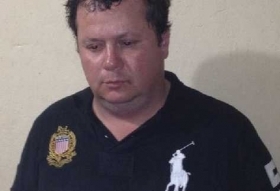Nicaraguan police say they have broken up a criminal network linked to Alejandro Jimenez Gonzalez, the man accused of plotting the attack that killed Argentine singer Facundo Cabral in Guatemala last year.
On May 27, Nicaragua’s National Police announced that they had arrested 11 people linked to Jimenez, including a prominent judge. According to judicial support director Glenda Zavala, the detained were members of a drug trafficking and money laundering network led by Jimenez (pictured), who was arrested in March.
The suspects include Judge Julio Cesar Ozuna, who has been charged with providing members of the criminal outfit with false identification cards. Karla Fariñas, sister of Nicaraguan Henry Fariñas — the target of the attack that killed Cabral — was also arrested.
Zavala said that police are working to discover the whereabouts of four more individuals linked to Jimenez.
InSight Crime Analysis
As with previous chapters in the Cabral case, the latest arrests serve to illustrate the transnational nature of organized crime in the region. Jimenez, a Costa Rican national, was arrested in Colombia on a boat which had set off from Panama. Officials claimed he had traveled to Colombia at the behest of Mexican kingpin Joaquin “El Chapo” Guzman, who instructed his contacts in Colombia’s Rastrojos gang to protect Jimenez.
The arrest of Ozuna also points to organized crime’s infiltration of political institutions in Nicaragua. Ozuna worked as a substitute judge on the Supreme Electoral Council, the organization tasked with overseeing elections in the country. His brother is the leader of the Liberal Constitutionalist Party, a right-wing opposition group. This demonstrates that, while Nicaragua may lack the kind of street crime and violence that characterizes other countries in Central America, it is by no means immune from corruption. A recent UNODC report documented the role that officials (both low and high-ranking) played in human trafficking in the country, while officials in the military have warned of corruption within its ranks.

